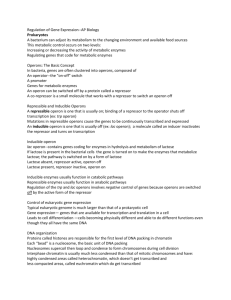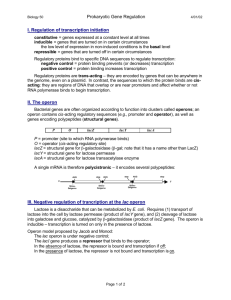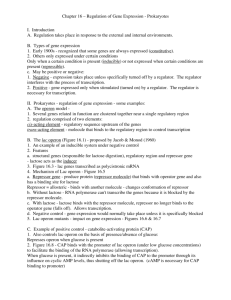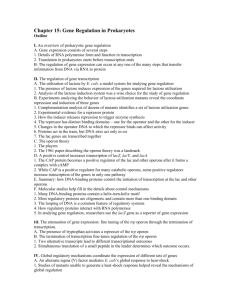Chapter 18 Slides
advertisement
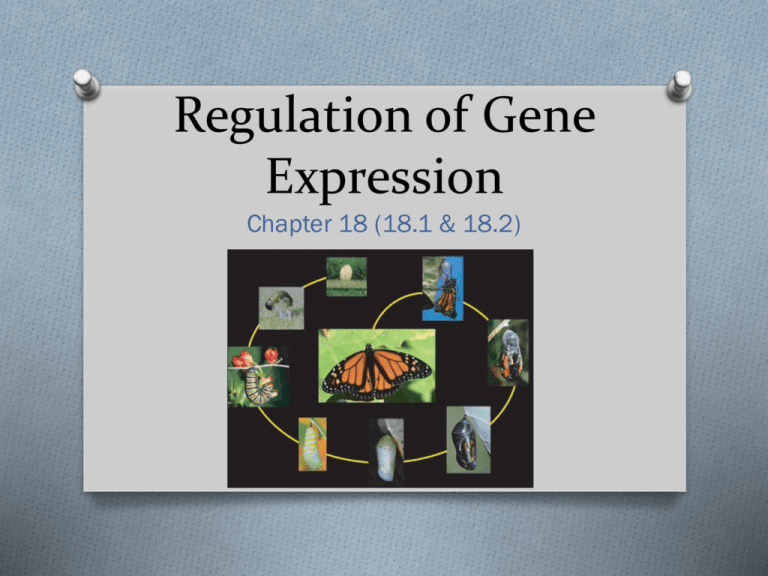
Regulation of Gene Expression Chapter 18 (18.1 & 18.2) Gene Expression O All cells contain the entire genome O In theory, every cell could make every single protein encoded in the genome O But that doesn’t happen! e.g. Lymphocytes of immune system are the only cells that make antibodies while red blood cells are the only cells that make the oxygen transport protein hemoglobin O Or sometimes the environment will influence which proteins are made and when O O The spatial (space) and temporal (time) select transcription of certain genes is called gene expression Gene Expression So how do different cells know which genes to use and which genes to ignore? O It’s a little complicated so let’s start with the prokaryotes! O Regulation in Prokaryotes Bacterial cells only make gene products when they are needed O Bacteria can use 2 methods to regulate this production: 1. Feedback regulation of enzymes 2. Gene expression regulation by the operon model O Regulation by Operons: Enzyme Production O Basic idea: Clusters of functionally related genes are under coordinated control O A single “on-off switch” O The switch is a DNA segment called an operator O Usually found inside the promoter O An operon is everything involved: operator, promoter and genes the operon controls Regulation by Operons O Operons can be switched off by proteins called repressors O Repressors prevent gene transcription by binding to operators and blocking RNA polymerase O Repressors are gene products of separate regulatory genes O Repressors can be active or inactive O Corepressors make repressors active so they can turn operons off (allosteric regulation) Regulation by Operons If repressor present and active: No transcription O No gene products made O If repressor absent or inactive: O Transcription occurs O Gene products made Negative Gene Regulation Operons can be repressible or inducible O Repressible operons are usually ON O O An active repressor can shut them off O Inducible operons are usually OFF Inducer molecule inactivates repressor and therefore turns on operon O Ex. lac operon is an inducible operon O Negative Gene Regulation O Repressible operons usually found in anabolic pathways (i.e. Pathways that make bigger molecules) O When enough product made, operon turns off O Inducible operons usually found in catabolic pathways (i.e. Pathways that break down molecules) O Presence of reactant molecule will turn on operon when necessary Example of Inducible Operon: lac operon O E.coli can metabolize both glucose or lactose as energy sources but it prefers glucose O If environmental glucose is low and lactose is high, lac operon transcribes genes for enzymes used to break down lactose O 3 genes needed for lactose metabolism: O lacZ gene codes for b-galactosidase: Breaks lactose into glucose and galactose O lacY gene codes for permease: Allows lactose into cell O lacA gene codes for transacetylase: Unknown role lac operon: If no lactose O Since the lac operon is inducible, it is normally OFF when no lactose O O Would be a waste to make enzymes to break down lactose if no lactose available lac operon normally switched off by ACTIVE repressor which binds to operator Repressor made by regulatory gene lacI O Repressor prevents RNA polymerase from transcribing operon’s genes (lacZ, lacY, lacA) O Regulatory gene Promoter Operator lacI lacZ No RNA made 3 5 RNA polymerase Active repressor (a) Lactose absent, repressor active, operon off i.e. No genes transcribed for lactose metabolism lac operon: Lactose present O If lactose present, b-galactosidase breaks down lactose into allolactose first O Allolactose binds to repressor, making it inactive Inactive repressor can’t block RNA polymerase so operon transcribes genes (lacZ, lacY, lacA) O Allolactose acts as an inducer in this role O lac operon lacI lacZ lacY lacA Permease Transacetylase RNA polymerase 3 5 b-Galactosidase Allolactose (inducer) Inactive repressor (b) Lactose present, repressor inactive, operon on i.e. Genes transcribed to metabolize lactose Regulation by Inducible Operons If lactose present: Allolactose (inducer) made O Inducer makes repressor INACTIVE O Operon ON O Genes for lactose metabolism transcribed O If lactose absent: No allolactose (no inducer) made O Repressor stays ACTIVE O Operon stays OFF O Genes for lactose metabolism NOT transcribed O Eukaryotic Gene Regulation O Remember that all cells are genetically identical O Yet each typical human cell only expresses 20% of its genes on average at a given time O How do cells have such differential gene expression? Eukaryotic Gene Regulation O Remember that all cells are genetically identical O Yet each typical human cell only expresses 20% of its genes on average at a given time O How do cells have such differential gene expression? O Lots of levels of eukaryotic gene expression control, from transcription to translation and beyond! Summary of stages of gene expression in eukaryotes Signal NUCLEUS Chromatin DNA Chromatin modification: DNA unpacking involving histone acetylation and DNA demethylation Gene available for transcription Gene Transcription RNA Exon Primary transcript Intron RNA processing Cap Tail mRNA in nucleus Transport to cytoplasm CYTOPLASM mRNA in cytoplasm Degradation of mRNA Translation Polypeptide Protein processing, such as cleavage and chemical modification Degradation of protein Active protein Transport to cellular destination Cellular function (such as enzymatic activity, structural support) Regulation of Chromatin Structure O Recall from Chapter 16 that eukaryotic DNA is wrapped around histone proteins, forming chromatin O Chromatin does more than just compact DNA to fit in nucleus O Amount of wrapping can control whether or not gene expression occurs O Tight wrapping = reduced transcription O Looser wrapping = more transcription O Heterochromatin regions very tightly wrapped with little transcription (telomere & centromere regions) Regulation of Chromatin Structure O Chemical modification to histones and DNA can also influence gene expression O Acetylation (adding acetyl groups, -COCH3) to positively charged histone tails reduces attraction to negatively charged DNA O Acetylation loosens chromatin = more transcription O Deacetylation (removing acetyl groups) = less transcription Acetylation of Histones Histone tails (+ charged) DNA double helix (- charged) Nucleosome (a) Positive tails attracted to negative DNA; Prevents transcription Unacetylated histones Acetylated histones (b) Acetylation makes histones less positive so less attraction to DNA; Permits transcription DNA Methylation O Methylation (adding methyl groups, -CH3) can occur on DNA itself, usually to cytosine nucleotides O In general, more methylation = less transcription O i.e. Methylation turns genes “off” O Ex. Inactivated genes on mammalian X chromosome that becomes Barr body are heavily methylated Remember those tortoise shell cats? DNA Methylation O Methylation patterns can be passed on from cell to cell O O Helps cells differentiate into cell types during embryonic development But methylation patterns can ALSO change, thus altering gene expression Epigenetics O But wait a minute! That’s a big deal! O Think about this: You inherit your gene sequence BUT the expression of those genes could change over time with DNA methylation changes Epigenetics Inheritance of traits not involving the nucleotide sequence is called epigenetic inheritance O Epigenetics has profound implications for human health O Ex. Could explain why one identical twin has a particular disease and one doesn’t O Ex. Some cancers shown to have a connection to epigenetic modification O



